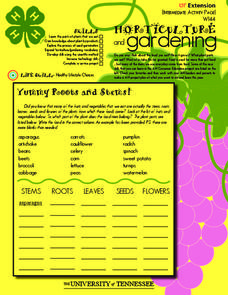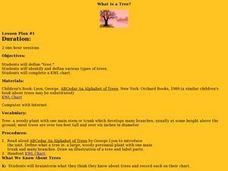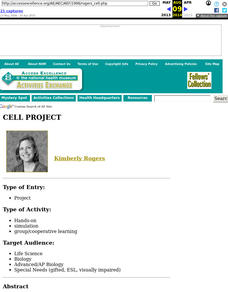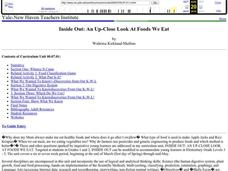Curated OER
History of a Cookie
Students examine tree rings and then research an event for each growth ring. In this history lesson students design a timeline and research topics using books and the Internet.
Curated OER
Wappo Indian Baskets
Third graders research the basket-making skills of the Wappo tribe and their other uses of plants. They compare Wappo designs and plant use with those of other tribes. They explore their neighborhoods for plants to make baskets.
Curated OER
The Biomass Balancing Act
Students work in groups to research biomass using the International Energy Agency's website. Students use evidence from the web search to assess biomass energy potential in Pennsylvania as part of a classroom "Alternative Energy...
Curated OER
'Water, Water Everywhere...'
Fourth graders explore how the Utah pioneers used irrigation to make the desert 'blossom as a rose'. They use geographical tools to analyze political and physical features of Utah, the United States, China, and Asia.
Curated OER
Horticulture and Gardening
In this colorful packet, students engage in a variety of activities involving plants and seeds. After answering the 50 questions in the packet, learners can go on to delve into their own projects.
Curated OER
Lesson 1: English-Indian Encounters
What did the English settlers think of the Native Americans inhabiting the Chesapeake region of the United States? Learners analyze a series of documents and images to determine the English perception of the local inhabitants. A great...
Curated OER
Wild Flower Project
Students photograph as many different kinds of wild flowers that they see around their school. In this wild flower lesson plan, students take different pictures of wild flowers after identifying their characteristics and coming up with a...
Curated OER
Cell Art
Combine art and science with this cell structure assignment. Learners depict a cell diagram, including the organelles, imitating a specific artist's style.
Curated OER
Pollination Parties
Young scholars discuss the pollination of bees and butterflies. In this pollination lesson,students complete a worksheet answering questions about an imaginary bee pollination company. Young scholars understand the relationship...
Curated OER
PLANT LIFE CYCLES
Student learns about the life cycle of plants by watching a time-lapse video. This activity provides students with further evidence that all living things grow and change as they progress through their life cycle. Student conducts a...
Curated OER
Garden of Eden
Students view a video clip about animals and their habitats. They work together to discuss how different animals adapt to their environments. They create a new habitat for a specific animal and draw new adaptations for them.
Curated OER
What is a Tree?
Students identify and define types of trees. In this tree identification lesson plan, students complete a KWL chart on trees and read the book ABCedar: An Alphabet of Trees. Students complete a tree word scramble.
Curated OER
Healthy Foods
Students view a video which explores the following statement. "You are what you eat." They discuss the food industry, organic foods, and healthy food choices. They chart what they eat on a daily basis and make plans for healthier options.
Curated OER
Medieval and Renaissance Art: Botanical Symbolism
Students study the significance of flowers in art from two periods. In this Medieval and Renaissance art lesson, students research the presence and meaning of botanical illustrations in twelfth, thirtieth, and fourteenth century...
Curated OER
Plants
Sixth graders examine how plants collect water and breathe. In groups, they participate in a variety of activities in which they discover how plants operate in terrariums. To end the lesson, they discuss why plants are important to the...
Curated OER
What's in a Garden?
Students explore the concept of philanthropy. In this service learning lesson, students plan a garden. Students write a paragraph in their journals giving their recommendation on how their garden should be laid out.
Curated OER
Cell Project
High schoolers investigate cells. They discover what cells are, where they are found, what they do and what they are made of. They construct a giant cell that is posted on the bulletin board.
Curated OER
The Superheroes of Public Land Management
Students study public land management agencies and their missions. They research a management agency, design a superhero to represent the agency and describe the skills and training needed to manage public lands. They include the...
Curated OER
Moths and Butterflies crossword puzzle
In this moths and butterflies worksheet, students complete a crossword puzzle about moths and butterflies. Students complete 26 blanks in the crossword puzzle.
Curated OER
Milkweed and Monarch Butterfly Puzzle
In this milkweed bug and monarch butterfly worksheet, students complete a crossword puzzle dealing with milkweed bugs and monarch butterflies. Students answer 15 questions in the puzzle.
Curated OER
Flowers, Flowers, Flowers...A Visit with Georgia O'Keeffe
Students analyze, discuss, and research Georgia O'Keeffe and her flower paintings. They select a flower to paint and create a watercolor painting in the style of Georgia O'Keeffe. Students compose a poem describing their painting.
Curated OER
Inside Out: An Up-Close Look At Foods We Eat
Fourth graders identify the origins of meats and vegetables consumed by humans on a daily basis. They classify foods (meats, dairy products, grains...) and create a food pyramid.
Curated OER
Information Fluency Unit
Fourth graders, after defining the task and searching for some creative strategies, role play being a Park Ranger who tries to save Big Bend from being removed from the National Park system in Texas. They support the keeping of Big Bend...
Curated OER
How do pollutants bioaccumulate and biomagnify?
Young scholars review the basic concepts of the food chain. In small groups, they research an organism and create a food web. In addition, they study biomagnifications and write a brief essay or make a poster informing others about the...

























